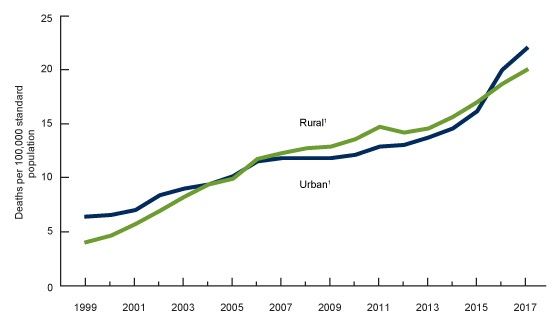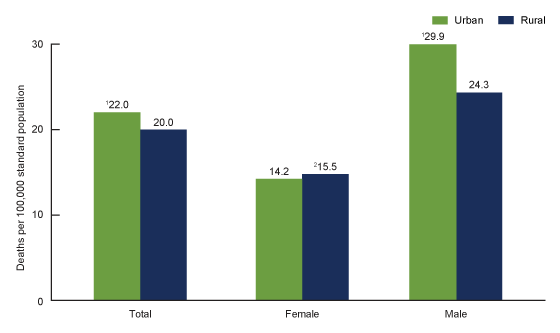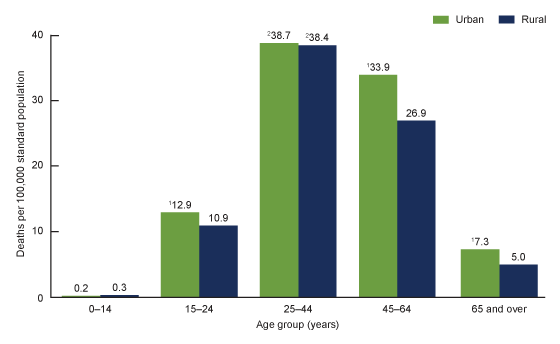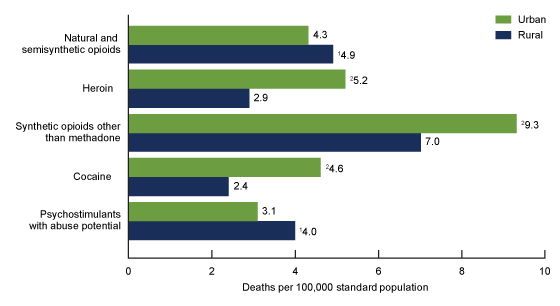Urban–rural Differences in Drug Overdose Death Rates, by Sex, Age, and Type of Drugs Involved, 2017
- Key findings
- From 1999 through 2017, the age-adjusted rate of drug overdose deaths increased in both urban and rural counties.
- In 2017, the rate of drug overdose deaths for females was higher in rural counties than in urban counties. For males, the rate was higher in urban counties than in rural counties.
- In 2017, drug overdose death rates were higher in urban areas for most age groups.
- In 2017, urban-rural differences in drug overdose death rates varied by the type of drug involved.
- Summary
- Definitions
- Data sources and methods
- About the authors
- References
- Suggested citation
NCHS Data Brief No. 345, August 2019
PDF Versionpdf icon (481 KB)
Holly Hedegaard, M.D., Arialdi M. Miniño, M.P.H., and Margaret Warner, Ph.D.
Key findings
Data from the National Vital Statistics System, Mortality
- The age-adjusted rate of drug overdose deaths was higher in urban than in rural counties (22.0 and 20.0 per 100,000, respectively).
- For males, rates were higher in urban than in rural counties (29.9 and 24.3). For females, rates were higher in rural than in urban counties (15.5 and 14.2).
- Rates were higher in urban than in rural counties for drug overdose deaths involving heroin (5.2 and 2.9), synthetic opioids other than methadone (9.3 and 7.0), and cocaine (4.6 and 2.4).
- Rates were higher in rural than in urban counties for drug overdose deaths involving natural and semisynthetic opioids (4.9 and 4.3), and psychostimulants with abuse potential (4.0 and 3.1).
Drug overdose deaths remain a significant public health concern in the United States (1–3). This report uses the most recent data from the National Vital Statistics System (NVSS) to examine urban–rural differences in drug overdose death rates by sex, age group, and the type of drugs involved.
Keywords: poisoning, opioids, heroin, National Vital Statistics System Mortality File
From 1999 through 2017, the age-adjusted rate of drug overdose deaths increased in both urban and rural counties.
- The age-adjusted rate of drug overdose deaths in urban counties increased from 6.4 per 100,000 in 1999 to 22.0 in 2017 (Figure 1). During this same period, the age-adjusted rate in rural counties increased from 4.0 to 20.0.
- From 1999 through 2006, the drug overdose death rate in rural counties increased faster than in urban counties (rural: average increase of 20% per year from 1999 through 2003 and 13% per year from 2003 through 2006; urban: 9% per year from 1999 through 2006). From 2006 through 2014, rates in both urban and rural counties showed slower growth (rural: average increase of 4% per year; urban: 3% per year). From 2014 through 2017, the rate in urban counties increased faster than in rural counties (average increase of 17% and 9% per year, respectively).
- From 1999 through 2003, drug overdose death rates were higher in urban counties than in rural counties. Rates were similar from 2004 through 2006, then higher in rural counties from 2007 through 2015. In 2016 and 2017, age-adjusted rates of drug overdose deaths were higher in urban than in rural counties.
Figure 1. Age-adjusted rates of drug overdose deaths, by urban and rural residence: United States, 1999–2017
1Significant increasing trend from 1999 through 2017 with different rates of change over time, p < 0.05. Rates were higher in urban than in rural counties from 1999 through 2003 and in 2016 and 2017. Rates in urban and rural counties were similar from 2004 through 2006. Rates were higher in rural than in urban counties from 2007 through 2015.
NOTES: Drug overdose deaths were identified using International Classification of Diseases, 10th Revision underlying-cause-of-death codes X40–X44, X60–X64, X85, and Y10–Y14. Decedent’s county of residence was classified as urban or rural based on the 2013 NCHS Urban–Rural Classification Scheme for Counties. Age-adjusted death rates were calculated using the direct method and the 2000 U.S. standard population. Access data table for Figure 1pdf icon.
SOURCE: NCHS, National Vital Statistics System, Mortality.
In 2017, the rate of drug overdose deaths for females was higher in rural counties than in urban counties. For males, the rate was higher in urban counties than in rural counties.
- In 2017, the age-adjusted rate of drug overdose deaths for females was higher in rural than in urban counties (15.5 and 14.2 per 100,000, respectively) (Figure 2).
- The age-adjusted rate of drug overdose deaths for males was higher in urban than in rural counties (29.9 and 24.3).
Figure 2. Age-adjusted drug overdose death rates, by sex and by urban and rural residence, 2017
1Significantly higher than rural rate, p < 0.05.
2Significatly higher than the urban rate, p < 0.05.
NOTES: Drug overdose deaths were identified using International Classification of Diseases, 10th Revision underlying-cause-of-death codes X40–X44, X60–X64, X85, and Y10–Y14. Decedent’s county of residence was classified as urban or rural based on the 2013 NCHS Urban–Rural Classification Scheme for Counties. Age-adjusted death rates were calculated using the direct method and the 2000 U.S. standard population. Access data table for Figure 2pdf icon.
SOURCE: NCHS, National Vital Statistics System, Mortality.
In 2017, drug overdose death rates were higher in urban areas for most age groups.
- In 2017, the rate of drug overdose deaths was higher in urban than in rural counties for persons aged 15–24 (12.9 and 10.9 per 100,000, respectively), 45–64 (33.9 and 26.9), and 65 and over (7.3 and 5.0) (Figure 3).
- The rate of drug overdose deaths was similar in urban and rural counties for persons aged 0–14 (urban: 0.2; rural: 0.3) and 25–44 (urban: 38.7; rural: 38.4).
- For both urban and rural counties, the rate of drug overdose deaths was highest among persons aged 25–44.
Figure 3. Rates of drug overdose deaths, by age group and by urban and rural residence, 2017
1Significantly higher than rural rate, p < 0.05.
2Significantly higher than for other age groups, p < 0.05.
NOTES: Drug overdose deaths were identified using International Classification of Diseases, 10th Revision underlying-cause-of-death codes X40–X44, X60–X64, X85, and Y10–Y14. Decedent’s county of residence was classified as urban or rural based on the 2013 NCHS Urban–Rural Classification Scheme for Counties. Access data table for Figure 3pdf icon.
SOURCE: NCHS, National Vital Statistics System, Mortality.
In 2017, urban-rural differences in drug overdose death rates varied by the type of drug involved.
- In 2017, the rate of drug overdose deaths involving natural and semisynthetic opioids (e.g., oxycodone, hydrocodone, morphine, and codeine) was higher in rural (4.9 per 100,000) than in urban (4.3) counties (Figure 4).
- The rate of drug overdose deaths involving heroin was higher in urban (5.2) than in rural (2.9) counties. Urban rates were also higher than rural rates for drug overdose deaths involving synthetic opioids other than methadone (e.g., fentanyl, fentanyl analogs, and tramadol) (9.3 and 7.0, respectively), and drug overdose deaths involving cocaine (4.6 and 2.4).
- The rate of drug overdose deaths involving psychostimulants with abuse potential (e.g., methamphetamine, amphetamine, and methylphenidate) was higher in rural (4.0) than in urban (3.1) counties.
Figure 4. Age-adjusted drug overdose death rates, by types of drugs involved and by urban and rural residence, 2017
1Significantly higher than urban rate, p < 0.05.
2Significantly higher than rural rate, p < 0.05.
NOTES: Drug overdose deaths were identified using International Classification of Diseases, 10th Revision underlying-cause-of-death codes X40–X44, X60–X64, X85, and Y10–Y14. Deaths involving specific drugs or drug types were identified using multiple-cause-of-death codes: natural and semisynthetic opioids, T40.2; heroin, T40.1; synthetic opioids other than methadone, T40.4; cocaine, T40.5; and psychostimulants with abuse potential, T43.6. Deaths involving more than one drug (e.g., a death involving both heroin and cocaine) were counted in both categories. In 2017, at least one specific drug was identified in 88% of drug overdose deaths. Decedent’s county of residence was classified as urban or rural based on the 2013 NCHS Urban–Rural Classification Scheme for Counties. Age-adjusted death rates were calculated using the direct method and the 2000 U.S. standard population. Access data table for Figure 4pdf icon.
SOURCE: NCHS, National Vital Statistics System, Mortality.
Summary
This report describes urban–rural differences in deaths from drug overdoses in the United States, by sex, age, and type of drugs involved.
The pattern in drug overdose mortality rates by urban and rural counties has varied over time. From 1999 through 2003, rates were higher in urban than in rural counties. Rates were similar from 2004 through 2006, then higher in rural counties from 2007 through 2015. In 2016 and 2017, age-adjusted rates of drug overdose deaths were higher in urban (20.0 per 100,000 in 2016 and 22.0 in 2017) than in rural (18.7 in 2016 and 20.0 in 2017) counties.
In 2017, among females, the rate of drug overdose deaths was higher for rural counties (15.5) than for urban counties (14.2). In contrast, among males, the rate was higher for urban counties (29.9) than for rural counties (24.3). Rates were higher for urban counties for persons aged 15–24, 45–64, and 65 and over. Urban and rural rates were similar for persons aged 0–14 and 25–44.
In 2017, the rates of drug overdose deaths involving heroin, synthetic opioids other than methadone, and cocaine were higher in urban counties than in rural counties. In contrast, the rates of drug overdose deaths involving natural and semisynthetic opioids and involving psychostimulants with abuse potential were higher in rural counties than in urban counties.
Definitions
Drug poisoning (overdose) deaths: Includes deaths resulting from unintentional or intentional overdose of a drug, being given the wrong drug, taking a drug in error, or taking a drug inadvertently.
Natural and semisynthetic opioids: Includes such drugs as morphine, codeine, hydrocodone, and oxycodone.
Psychostimulants with abuse potential: Includes such drugs as methamphetamine, amphetamine, and methylphenidate.
Synthetic opioids other than methadone: Includes such drugs as fentanyl, fentanyl analogs, and tramadol.
Data sources and methods
Estimates are based on the NVSS multiple-cause-of-death mortality files available on CDC WONDER (4). Drug poisoning (overdose) deaths were defined as having an International Classification of Diseases, 10th Revision (ICD–10) underlying-cause-of-death code of X40–X44 (unintentional), X60–X64 (suicide), X85 (homicide), or Y10–Y14 (undetermined intent) (5). Of the drug overdose deaths in 2017, 87% were unintentional, 7% were suicides, 5% were of undetermined intent, and less than 1% were homicides. The type of drug(s) involved are indicated by ICD–10 multiple-cause-of-death codes: heroin (T40.1); natural and semisynthetic opioids (T40.2); synthetic opioids other than methadone (T40.4); cocaine (T40.5); and psychostimulants with abuse potential (T43.6).
Urbanization level of the decedent’s county of residence was initially categorized using the 2013 NCHS Urban–Rural Classification Scheme for Counties (6). In this scheme, counties are classified into six urbanization levels based primarily on metropolitan–nonmetropolitan status and population distribution. Metropolitan counties include large central counties, the fringes of large counties (suburbs), medium counties, and small counties. Nonmetropolitan counties include micropolitan statistical areas and noncore areas, including open countryside, rural towns (populations of less than 2,500), and areas with populations of 2,500–49,999 that are not part of larger labor market areas. For this report, the four metropolitan categories (i.e., large central metro, large fringe metro, medium metro, and small metro) were grouped as urban counties. The two nonmetropolitan categories (i.e., micropolitan and noncore) were grouped as rural counties. Trends in mortality rates in the six more detailed urbanization categories may differ from the trends observed in the two groups (urban and rural) used in this report.
Age-adjusted death rates were calculated using the direct method and adjusted to the 2000 U.S. standard population (7). Trends in age-adjusted death rates were evaluated using the Joinpoint Regression Program (Version 4.3.1.0) (8). Joinpoint software fitted weighted least-squares regression models to the rates on the log transform scale. Analyses were set to allow a maximum of three joinpoints across the period, a minimum of three observed time points from any given joinpoint to either end of the data, and a minimum of four observed time points between any two joinpoints. The permutation tests for model (number of joinpoints) significance were set at an overall alpha level of 0.05 (9). Pairwise comparisons of rates in Figures 1–4 were conducted using the z test statistic with an alpha level of 0.05 (two-sided) (7). All comparisons mentioned were statistically significant.
Several factors related to death investigation and reporting may affect measurement of death rates involving specific drugs. At autopsy, the substances tested for and the circumstances under which the toxicology tests are performed may vary by jurisdiction. This variability is more likely to affect substance-specific death rates than the overall drug overdose death rate. In 2017, 87.8% of drug overdose deaths in urban counties and 86.2% of deaths in rural counties identified at least one specific drug or drug class.
Additionally, drug overdose deaths may involve multiple drugs; therefore, a single death might be included in more than one category when describing the rate of drug overdose deaths involving specific drugs. For example, a death that involved both heroin and fentanyl would be included in both the rate of drug overdose deaths involving heroin and the rate of drug overdose deaths involving synthetic opioids other than methadone.
About the authors
Holly Hedegaard is with the National Center for Health Statistics (NCHS), Division of Analysis and Epidemiology. Arialdi Miniño and Margaret Warner are with the NCHS, Division of Vital Statistics.
References
- Hedegaard H, Miniño AM, Warner M. Drug overdose deaths in the United States, 1999–2017pdf icon. NCHS Data Brief, no 329. Hyattsville, MD: National Center for Health Statistics. 2018.
- Ahmad FB, Rossen LM, Spencer MR, Warner M, Sutton P. Provisional drug overdose death counts. National Center for Health Statistics. 2019.
- Scholl L, Seth P, Kariisa M, Wilson N, Baldwin G. Drug and opioid-involved overdose deaths—United States, 2013–2017. MMWR Morb Mortal Wkly Rep;67:1419–27. 2019.
- Centers for Disease Control and Prevention. CDC WONDER. Multiple cause of death data, 1999–2017.
- World Health Organization. International statistical classification of diseases and related health problems, 10th revision (ICD–10). 2008 ed. Geneva, Switzerland. 2009.
- Ingram DD, Franco SJ. 2013 NCHS Urban–rural classification scheme for counties. National Center for Health Statistics. Vital Health Stat 2(166)pdf icon. 2014.
- Murphy SL, Xu JQ, Kochanek KD. Deaths: Final data for 2010pdf icon. National Vital Statistics Reports; vol 61 no 4. Hyattsville, MD: National Center for Health Statistics. 2013.
- National Cancer Institute. Joinpoint Regression Program (Version 4.3.1.0) [computer software]. 2016.
- Ingram DD, Malec DJ, Makuc DM, Kruszon-Moran D, Gindi RM, Albert M, et al. National Center for Health Statistics guidelines for analysis of trends. National Center for Health Statistics. Vital Health Stat 2(179). 2018.
Suggested citation
Hedegaard H, Miniño AM, Warner M. Urban–rural differences in drug overdose death rates, by sex, age, and type of drugs involved, 2017. NCHS Data Brief, no 345. Hyattsville, MD: National Center for Health Statistics. 2019.
Copyright information
All material appearing in this report is in the public domain and may be reproduced or copied without permission; citation as to source, however, is appreciated.
National Center for Health Statistics
Jennifer H. Madans, Ph.D., Acting Director
Amy M. Branum, Ph.D., Acting Associate Director for Science
Division of Analysis and Epidemiology
Irma E. Arispe, Ph.D., Director
Kevin C. Heslin, Ph.D., Associate Director for Science
Division of Vital Statistics
Steven Schwartz, Ph.D., Director
Hanyu Ni, Ph.D., M.P.H., Associate Director for Science



